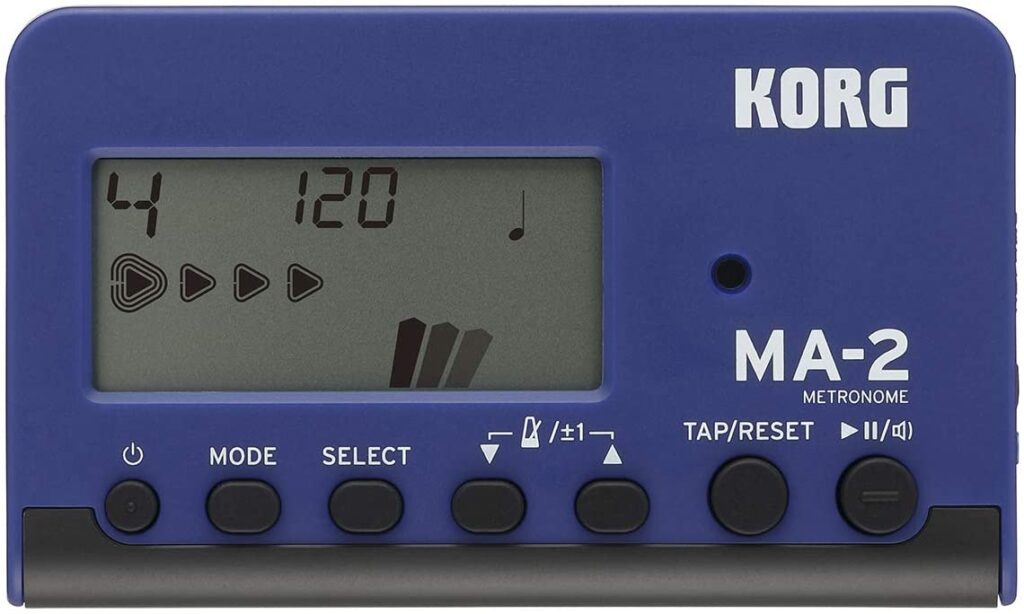I have always found in my teaching that it’s usually difficult to get students to practice with a metronome. There are several reasons for this. The first is that they simply don’t understand the importance of good time for a percussionist and how practicing with a metronome will help them to develop it. Good time is important for all musicians but it’s especially crucial for drummers. In many styles of music, including rock, pop, country, jazz, funk, blues, latin and marching music, the drums really drive the tune. I explain to my students that when you’re playing drum-set in a group, you’re usually replacing the conductor. If a trumpet player’s time in a band isn’t perfect, most people won’t notice. If a drummer can’t keep time, it’s virtually impossible for a band to play together. The drummer simply has more control over this than anyone else in the group.
Practicing with a metronome is simply the best way to develop your sense of time. I’ve had to suppress a chuckle several times in my teaching when students have told me that they don’t like practicing with a metronome because it slows down and speeds up all the time! I’ve had to patiently explain that it’s not the metronome, it’s the student.
Yes there are other ways to develop your time. You can play along with recordings. You can play along with a drum machine or other rhythm track. But none of these has ever proved as effective for developing your inner sense of time as practicing with a metronome.
I usually use the analogy of weight lifting when trying to explain the scientific nature of this method of practicing. Let’s say I can easily bench press 100 lbs. Now I say to my personal trainer, or weight lifting partner, “Let’s increase the weight.” We don’t measure the weight we put on the bar bell in any way, so all of the sudden, without knowing it, we jump from 100 lbs to 300 lbs. Now the weight is crushing me. The same thing happens when we don’t practice with a metronome. We can play an exercise easily at one tempo. Then we decide to play it a little faster. Now it’s incredible difficult because without knowing it we’ve doubled our speed. We simply weren’t ready to play it this fast yet. We needed to work up to it. The metronome allows you to measure exactly how much you’re increasing the speed of a given exercise or musical passage, so you can work it gradually, a little at a time.
Another reason it’s hard to get students to practice with a metronome is that it’s simply very difficult for them in the beginning. The way I overcome this in my teaching is simply to make it as easy as possible. Just like gradually increasing the speed, you have to go through various levels of difficulty to get comfortable with the metronome. I recommend starting by playing quarter notes at a medium tempo that’s comfortable. Play these with one hand only as that’s the easiest. If you get off track stop, and count quarter notes out loud with the metronome. Then start playing along again. Repeat this over and over until it’s comfortable, then move the speed up about 10 notches and repeat the process. Gradually work up your speed until you’re at a quarter note=200 on the metronome. This is the first, and most basic exercise to be done with the metronome.
Next divide that speed in half, so 200 becomes 100. Set the metronome on 100. The metronome is playing quarter notes. Count 8th notes along with the metronome, twice as fast as the metronome is playing. Now the metronome is playing quarter notes, 1,2,3, 4. You’re counting 1 and 2 and 3 and 4 and. This way the ears are trained to hear 8th notes against a quarter note pulse. After you’re comfortable at this tempo, move the metronome up as you did before, about 10 notches at a time.
The last step in this basic exercise is to put the metronome on about quarter note=65-85. Now, as the metronome plays quarter notes, count 16th notes out loud, 1 e and a, 2 e and a, 3 e and a, 4 e and a. Follow the same steps as before. Start pplaying 16th notes with one hand. As this becomes comfortable, start alternating hands, RLRL, till that’s comfortable. If you get off track at any point, stop playing and try just counting instead. Then come back in playing again. Again as you’re comfortable, move the metronome up about 10 notches at a time, gradually increasing the speed, as you did before.
After practicing this whole routine for a week or two, you should be pretty comfortable playing with a metronome. The next thing to do is simply start practicing other things the same way. Try a very basic rock beat, then maybe paradiddles. Eventually, you should start practicing everything with a metronome. Follow this process, and it really becomes a part of you eventually. Playing with it becomes second nature.
Here is the metronome I personally use and recommend. It’s very inexpensive and works great! Here is the link to purchase it at Amazon.com.


Comments are closed.